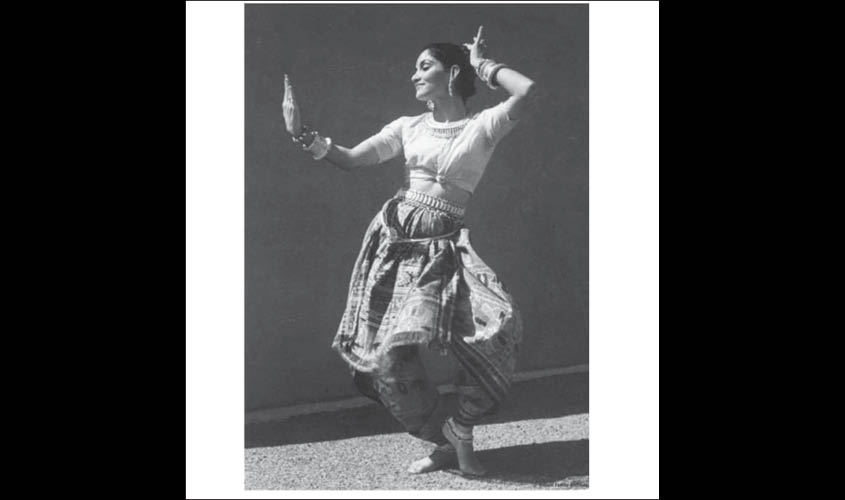Sukanya Rahman’s new book, Dancing in the Family, is an inter-generational memoir about the dancing careers of her mother and grandmother, and her own education in classical dance.
Dancing in the Family
Sukanya Rahman; Speaking Tiger Books; Pages: 256; Price: Rs 399
The life of a dancer—as I learned from my grandmother and mother—isn’t always adoring audiences, standing ovations or beautiful garlands of flowers. In my own dance incarnation, there were the inevitable highs and lows. It was when I was recruited as a guinea pig for the Artists in Schools Programme in Maine that I encountered some of my lows. Staggering out of bed at the crack of dawn, painting my face, getting into full costume, and then driving my ancient Plymouth Catalina to an assigned school was a constant challenge. I once arrived at a school in a snowstorm. As I stepped out of my car, smoke began to spew out of the engine. The students, whose faces were glued to the window, screamed in excitement: “The Indian dancer has arrived, the Indian dancer has arrived!”—impressed no doubt at my arrival in a puff of smoke! One of my gigs was an invitation to perform at my sons’ elementary school in Harpswell Island, Maine. When I stepped on stage, the student’s jaws dropped… (Did they think I had descended from the moon?) They received my performance with much enthusiasm and bombarded me at the end with questions: “Why do you have a red dot on your forehead? Why are your feet and the palms of your hands painted orange? Are those real flowers in your hair? Do all the women in India wear bells around their ankles?” Once back home, as we were sitting down to dinner, my older son turned to me and said, “Ma, don’t ever come to our school dressed like that again.” I complied, thinking back to the times the grown-ups in my family had mortified me with their behaviour. My grandmother, Ragini Devi, was especially not one to follow convention.
Some months after her death in 1982, my mother handed over to me for safekeeping Ragini’s most precious possessions. Stuffed into several large shopping bags, bearing the names of an assortment of New York City stores, were bulky photo albums, Bible records of the Parker/Abbott families dating back to 1660, Ragini’s certificate of marriage to my grandfather, a collection of expired passports, old affidavits, documents and a few personal letters. Sifting through the contents of the bags many years later one of the letters, addressed to a “Mrs. Bradley” grabbed my attention. Written from Bangalore on 19 February 1931, the three-page letter described in detail my grandmother’s journey to India, a broken love affair, and the birth of my mother Indrani. Much of the information in the letter I was already familiar with. Over the years, my mother, who was a marvelous storyteller, had entertained family and friends with outrageous anecdotes of growing up with the strong, independent, unconventional mother who had dragged her across the world and raised her to become a dance superstar. It was in reading the Bradley letter that I was struck for the first time by the sheer bravura of a woman who had broken down all barriers in pursuit of a dream.
By the time I came to know my grandmother, she was quite matronly, retired from the stage and struggling to complete her second book on Indian dance. The great-grandmother my two sons remember was a stooped
In 1994, my children, then in their teens, were in the audience for my performance at the Chocolate Church Arts Center in Bath, Maine—my younger son Wardreath with a girlfriend in tow. At the end of the performance, Habib, my older son, surprised me by asking if I would come to his college and repeat my performance. He arranged for my fee from various departments of Bates College. Every seat in the Schaeffer Theatre was packed. At my final namaskar, I was stunned by the thunderous applause and standing ovation from the students. I stood on stage feeling like Madonna. Though that was nothing compared to the feeling when Habib stepped on stage and presented me with a bouquet of flowers in full sight of all his peers! I floated off the stage in ecstasy and announced to my husband and children waiting in the wings:
“Guys, that was my last performance, my swan song.”
These voices, these images and the shopping bags bulging with my grandmother’s precious possessions, are my legacies to my children and grandchildren.
Extracted with permission from ‘Dancing in the Family: The Extraordinary Story of the First Family of Indian Dance’, by Sukanya Rehman, published by Speaking Tiger Books

